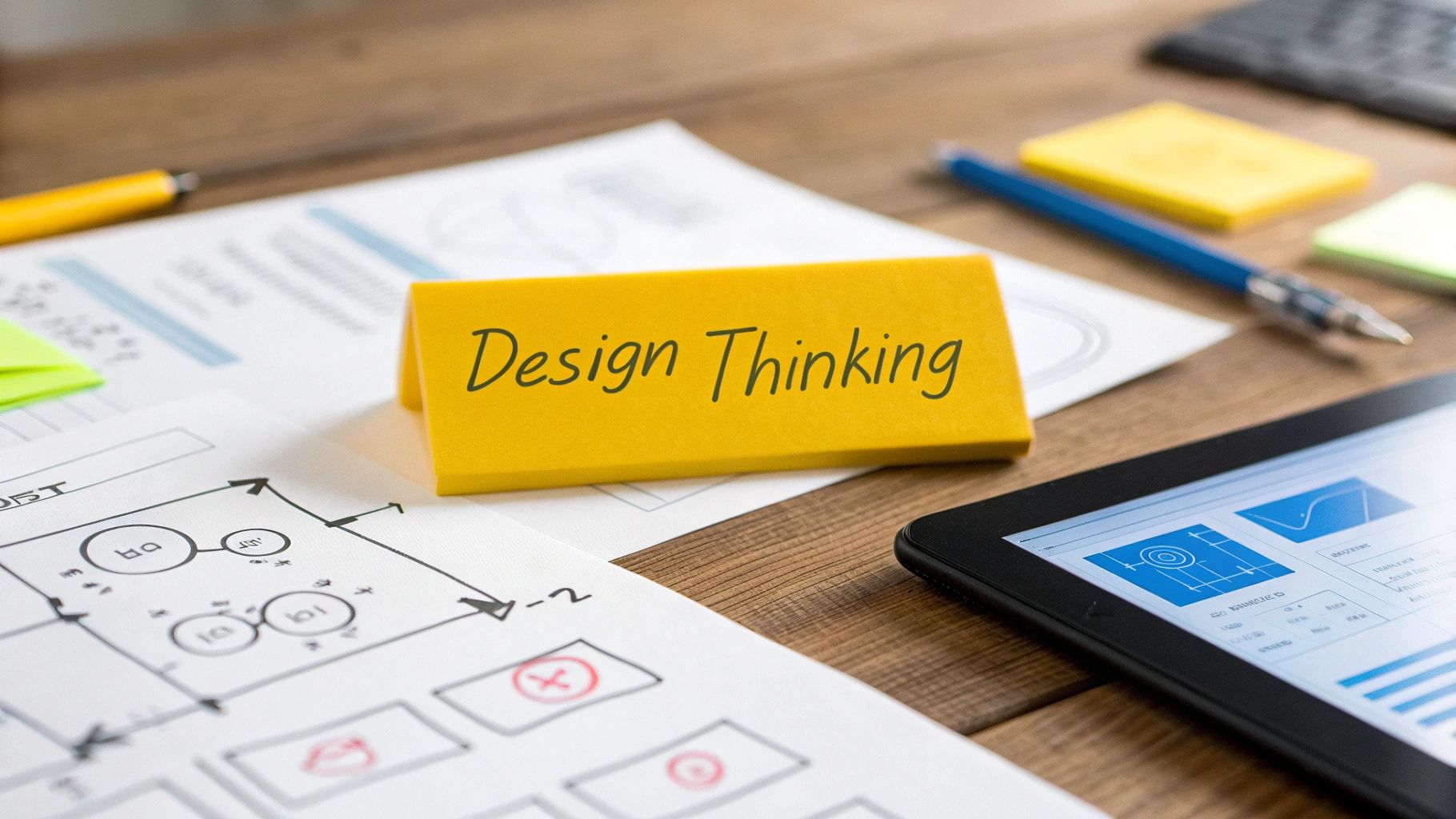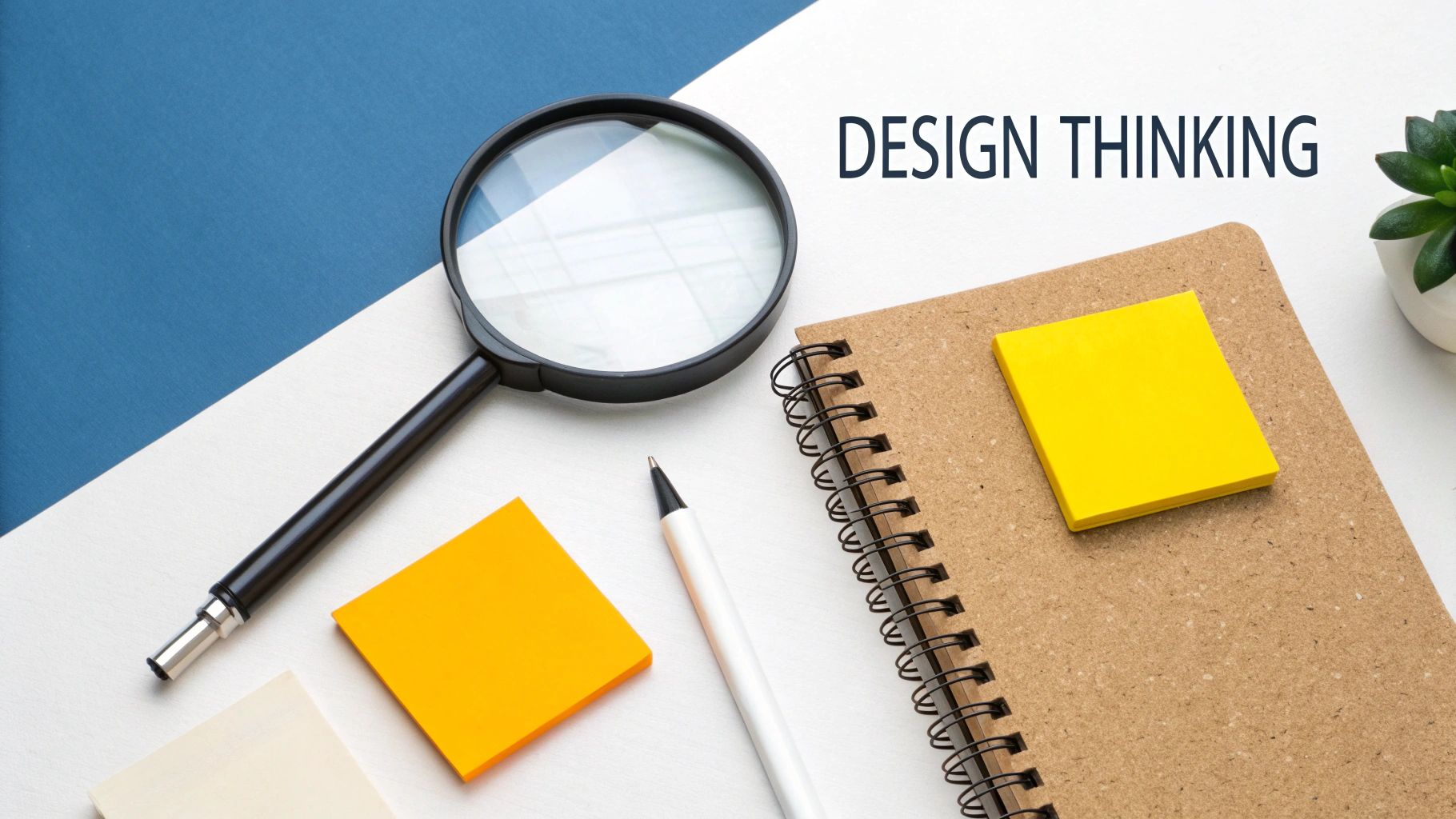What Is Design Thinking Process A Practical Guide

At its heart, design thinking is a problem-solving approach that puts people first. It’s an iterative, hands-on method that’s less about following a rigid checklist and more about deeply understanding the people you’re designing for. The whole point is to challenge assumptions, redefine problems, and create innovative solutions that genuinely resonate with users.
Unpacking the Design Thinking Framework
Think of the design thinking process like a detective solving a complex case. A good detective doesn't just chase the first lead; they start by getting to know the people involved, carefully gathering clues, and piecing together a story. They form theories and then test them against reality. That’s exactly what design thinking does—it guides teams on a journey of discovery to ensure the final solution is grounded in real human needs, not just business assumptions.
This is a fundamental shift from the old way of doing things, where a company might build a product and then hope to find an audience for it. Design thinking flips that completely. It begins with empathy and a deep dive into the user's world to see the problem through their eyes. To get a handle on this crucial first step, it’s worth learning how to conduct user research and gather those initial, game-changing insights.
The Five Stages of Design Thinking
The journey is typically broken down into five core stages. It’s important to remember that this isn't a strict, linear path. In reality, teams often jump back and forth between stages as new information comes to light. This flexibility is one of its biggest strengths, allowing for constant learning and refinement.

This people-first focus is what makes the difference. It ensures that the solutions aren't just technically possible but are truly desirable. It’s about building things that people actually want to use because they solve a real problem in a way that feels natural and satisfying.
The Five Stages of Design Thinking at a Glance
To make it even clearer, let's break down each stage and its primary goal. Think of this table as your cheat sheet for the entire process, a quick way to see how each step contributes to the bigger picture of innovation.
| Stage | Primary Goal |
|---|---|
| Empathize | Get a deep, personal understanding of your users' needs, feelings, and pain points. |
| Define | Use your research to craft a clear, actionable problem statement from the user's perspective. |
| Ideate | Brainstorm a wide range of creative, "no-bad-ideas" solutions to the defined problem. |
| Prototype | Build quick, low-cost, tangible versions of your ideas to see how they feel in the real world. |
| Test | Put your prototypes in front of real users to get feedback and learn what works (and what doesn't). |
Each stage flows logically into the next, forming a powerful cycle of understanding, creating, and validating. This structure gives teams the confidence to move through uncertainty and dramatically lowers the risk of building something nobody wants.
Tracing the Roots of Design Thinking
To really get a feel for design thinking, it helps to know where it came from. This isn't some new-age business fad that popped up overnight. Its roots run deep, growing over decades from a niche academic idea into a practical problem-solving toolkit used by some of the biggest companies in the world.
The story really kicks off back in the 1960s with the design methods movement. Academics like Herbert Simon started looking at design less as a mysterious art and more as a science for solving incredibly messy, complicated challenges—what he famously called "wicked problems." Think of things like tackling urban poverty or redesigning a city's public transit system. There's no single right answer for problems like these.
This shift in perspective—seeing design as a structured way to solve complex problems—laid the foundation for everything that followed.
From Theory to Business Practice
The concept took a major leap forward in the 1990s, thanks in large part to the design and innovation firm IDEO. They were instrumental in taking these academic theories and translating them into a repeatable process that businesses could actually use. Suddenly, you didn't need to be a designer to think like one.
This was a pivotal moment. Design thinking moved out of the university lecture hall and into the corporate boardroom. IDEO polished the process, putting a huge emphasis on understanding the end-user. Empathy became the bedrock of strategy, a stark contrast to the way most businesses operated at the time.
"The main tenet of design thinking is empathy for the people you're trying to design for. Leadership is exactly the same thing—building empathy for the people that you're entrusted to help."
– David Kelley, Founder of IDEO
This intense focus on the human element ensured that the solutions being created weren't just functional, but genuinely desirable to the people who would use them. That simple idea remains at the heart of the methodology today.
Solidifying the Modern Framework
The final piece of the puzzle clicked into place in the early 2000s with the founding of Stanford University’s Hasso Plattner Institute of Design, better known as the d.school. The d.school is largely responsible for popularizing the five-stage model we know today: Empathize, Define, Ideate, Prototype, and Test.
This educational push cemented design thinking as a core skill for modern innovation, and its influence spread far beyond the world of product design. The journey from the 1960s to the 2000s was a steady evolution. It started with Herbert Simon's work on "wicked problems" in his 1969 book "The Sciences of the Artificial," was brought into the mainstream by firms like IDEO in the 90s, and was finally standardized by Stanford's d.school in 2004. If you're curious, you can dive deeper into this timeline and explore a detailed history of design thinking.
This graphic from the Interaction Design Foundation gives a great visual summary of how the methodology developed over time.
As you can see, the concept matured from a theoretical pursuit into a structured, actionable process that innovators everywhere rely on.
Looking back, you can see how each era added another layer, refining the process into the powerful and flexible framework we have today for tackling big challenges and creating things people truly love.
Navigating the Five Stages of Design Thinking
It’s tempting to see the design thinking process as a rigid, step-by-step formula, but that’s not really how it works. Think of it more like a flexible roadmap than a set of turn-by-turn directions. Each stage feeds into the others, creating a dynamic cycle of learning and refining that helps teams cut through the fog of ambiguity and find real clarity.
While the journey is rarely a straight line, it's built around five core stages. Getting a feel for what happens in each one is the key to unlocking this powerful way of solving problems. The whole point is to move from deeply understanding people to creating things that genuinely help them.

Let's dive into what each of these stages looks like in the real world.
Stage 1: Empathize
Everything in design thinking starts and ends with people. The Empathize stage is all about developing a deep, almost personal, understanding of your users' world. This isn't about spreadsheets and demographic data; it’s about getting to the heart of their motivations, frustrations, and the needs they can’t even put into words.
The goal here is to get out of the office and into their environment. You're trying to see the world through their eyes and feel the friction they experience every day. To kick things off, knowing how to conduct user research effectively is absolutely critical for gathering those rich, human insights.
Here are a few ways teams build empathy:
- User Interviews: Sit down and have real conversations. You’ll hear personal stories and experiences you could never get from a survey.
- Observation: Simply watch how people interact with a product or navigate a process. Seeing their natural behavior is incredibly revealing.
- Immersion: Try walking a mile in their shoes. By actively participating in their experience, you gain a firsthand appreciation for their daily challenges.
This stage is the foundation. It ensures the solutions you dream up later are grounded in real human problems, not just your team's assumptions.
Stage 2: Define
Once you’ve gathered a mountain of notes, stories, and observations from the Empathize stage, it’s time to make sense of it all. The Define stage is where you distill everything you've learned into a clear, actionable problem statement. This is about turning chaos into clarity.
You’re not just listing out everything that’s wrong. You’re zeroing in on the right problem to solve, framed entirely from the user's point of view. A great problem statement is human-centered, broad enough to allow for creative solutions, but focused enough to be manageable.
The goal is to frame the problem from the user's perspective, not the company's. Instead of saying what you want to achieve, you state what the user needs.
For instance, a business-first statement might be, "We need to boost our app's user engagement by 15%." A human-centered one sounds more like this: "Busy working parents need a simple way to plan healthy family meals because they lack the time and energy for complex recipes."
See the difference? This reframing gives the team a clear, inspiring mission and acts as a north star for the rest of the project. Many of the principles here overlap with the broader UX design process steps, where defining the problem is also a crucial early milestone.
Stage 3: Ideate
With a focused problem statement lighting the way, the Ideate stage is where your team’s creativity truly gets to shine. The mission here is simple: generate as many ideas as possible to solve the problem. This is a time for thinking wide, not deep. Quantity over quality is the mantra.
The "no bad ideas" rule is absolutely essential. By putting judgment on hold, you create a safe space where people feel free to share wild, unconventional, or even seemingly silly suggestions. The most groundbreaking solutions often start as one of these "out there" ideas.
A few popular techniques to get the ideas flowing include:
- Brainstorming: The classic group jam session focused on getting every last idea out on the table.
- "How Might We" Questions: Rephrasing the problem to spark solutions (e.g., "How might we make meal planning feel effortless for tired parents?").
- Mind Mapping: A visual way to connect thoughts and explore unexpected creative paths.
By the end of this stage, you should have a huge pool of potential solutions ready to move into the next phase.
Stage 4: Prototype
The Prototype stage is where ideas start to become real. A prototype isn't the final product; it's a rough, experimental version of a solution that lets you test your concepts quickly and cheaply. The keywords here are speed and low fidelity. You are building to learn, not to launch.
Prototypes can be anything from a few sketches on paper to a clickable digital mockup. The goal isn't polish or perfection. It's to create just enough of a model to get it in front of users and see how they react.
Think of an architect building a small cardboard model before drafting the final blueprints for a skyscraper. That simple model lets them test the building's layout and feel without pouring a single yard of concrete. Prototypes do the same for your ideas—they let you fail fast and cheap, gathering priceless lessons before you invest serious time and money.
Stage 5: Test
Finally, the Test stage is where the rubber meets the road. You put your low-fi prototypes into the hands of real users and watch what happens. The goal is to get honest feedback, see what works, what doesn't, and figure out how to make your solution better.
During testing, you're not defending your idea; you're observing and listening. How do people interact with the prototype? What do they say? What are they thinking and feeling? This feedback is gold because it shines a light on flawed assumptions and uncovers insights you completely missed.
The results from testing rarely mean you’re done. In fact, they usually send you back to an earlier stage in the cycle.
- Harsh feedback might send you right back to the Ideate stage to come up with new approaches.
- User confusion could mean you need to revisit the Define stage and sharpen your problem statement.
- Surprising insights might even send you all the way back to Empathize to dig deeper into your users' world.
This constant looping is the real magic of design thinking. It's a continuous cycle of listening, building, and learning that pulls you closer and closer to a solution people will actually love.
The Mindset Behind the Methodology
Knowing the five stages of design thinking is a bit like having a recipe. You might have all the ingredients listed, but that doesn't mean you know how to cook. The real magic isn't just following the steps; it's about adopting the mindset that makes those steps work. These core principles are the secret sauce that turns a mechanical process into a true engine for innovation.
Without this way of thinking, teams often just go through the motions. They might run interviews but miss the genuine empathy, or brainstorm ideas that are just rehashes of old ones. Embracing these principles helps you graduate from a simple checklist to building a real culture of creative problem-solving.

A Deep Focus on Human Needs
First and foremost, design thinking is relentlessly human-centered. It all starts with the foundational belief that to build anything great, you have to truly understand the people you're building it for. This means digging deeper than what users say they want to uncover the needs they can't even articulate.
This is what elevates design thinking beyond basic market research. You’re not just a data collector. You're trying to build a genuine connection and understand someone's world—their frustrations, their workarounds, their goals. It’s the difference between asking "What features do you want?" and asking "Walk me through what you’re trying to get done here."
Embracing Ambiguity and Uncertainty
Most business processes are built to kill risk and create a predictable path forward. Design thinking, on the other hand, actually welcomes ambiguity. It gives teams permission to sit with a messy, complex problem—what some call a "wicked problem"—without a knee-jerk reaction to solve it immediately.
Getting comfortable with the unknown is crucial. It creates the breathing room you need to explore the problem from every angle, question assumptions you've held for years, and unearth insights that a rigid, linear process would have bulldozed right over. You have to trust that clarity will eventually emerge from the chaos.
"It’s not ‘us versus them’ or even ‘us on behalf of them.’ For a design thinker it has to be ‘us with them'."
– Tim Brown, former CEO and President of IDEO
This philosophy of working with people in an open-ended way is what leads to breakthroughs, not just small tweaks to what you’re already doing.
Radical Collaboration and Diverse Teams
Big ideas rarely come from one person working in a vacuum. Design thinking is a team sport that thrives on radical collaboration. The whole point is to bring people together from completely different corners of the business—think engineering, marketing, sales, and design—to look at the problem through a shared lens.
This mix of perspectives is a creative superpower. An engineer immediately sees what's possible with technology. A marketer instinctively knows what the market might crave. A designer can envision how it all feels to the user. When you blend those viewpoints, you start generating solutions that are:
- Desirable: People actually want it.
- Feasible: You can technically build it.
- Viable: It makes sense for the business.
This fusion of expertise is the perfect antidote to the kind of tunnel vision that can sink a project before it even starts.
A Bias Toward Action and Experimentation
Design thinking is anything but a theoretical debate. It's intensely practical and hands-on, built on a core principle: a bias toward action. Instead of spending months arguing over an idea in meetings, the goal is to get something tangible built and tested as quickly as humanly possible.
This is where the "Prototype" and "Test" stages truly shine. The mantra is "build to think and learn." By creating low-cost, rough-and-ready prototypes, teams make their abstract ideas real. This lets them get crucial feedback from actual users right away, turning potential failures into cheap learning opportunities instead of expensive mistakes down the road. This rapid loop of making, testing, and learning is what fuels real progress.
How Real Companies Use Design Thinking
Theory is one thing, but seeing design thinking in action is where it really clicks. This isn't some abstract concept for Silicon Valley startups; it's a powerful, human-first method that global brands use to tackle massive, real-world challenges. When we look at companies like Airbnb and Bank of America, we can see exactly how the five stages translate into game-changing results.
These stories prove that starting with empathy—getting into the customer's world and seeing through their eyes—uncovers opportunities that spreadsheets and market reports simply can't. It's all about finding the human problem hiding behind the business problem.
Airbnb: From Near Failure to Global Giant
Believe it or not, Airbnb was once on the verge of collapse. They had listings, but bookings were painfully low. Instead of tweaking their marketing or slashing prices, the founders went back to the drawing board with a design thinking mindset. They jumped straight into the Empathize stage, digging into their own user data and noticing a glaring pattern: the photos on their New York City listings were terrible.
This led them to form a hypothesis. If potential guests couldn't actually picture themselves staying in a place, they’d never click "book." This insight helped them Define the problem in a new way. It wasn't "How do we get more traffic?" but rather, "How do we make our listings feel trustworthy and appealing?"

The solution they came up with was radically simple. They flew to New York, rented a good camera, and went door-to-door, taking professional photos of their hosts' apartments completely free of charge. This was a real-world Prototype of what a professional photography service could do. The results from this Test were instant and stunning. The week after the new photos went live, revenue doubled. What started as a simple, empathy-driven experiment became a core part of their global growth strategy.
This story shows that sometimes the most powerful solutions aren't complex technological feats but simple, human-centric interventions discovered by getting close to the user's actual experience.
Bank of America: Redefining Savings
Bank of America wanted to bring in more customers, especially people who found it hard to save money. Rather than just launching another generic savings account, they teamed up with the design firm IDEO to tackle the problem. Their teams went deep into the Empathize stage, spending weeks with families to observe their financial habits up close. They didn't just ask about banking; they watched how people managed everything from grocery shopping to paying bills.
During the Define stage, they uncovered a crucial insight. They noticed many people—moms in particular—would round up amounts in their checkbooks to the next dollar to make the math easier. This created a tiny, informal savings buffer without them even thinking about it.
This small, almost unconscious behavior sparked a huge idea in the Ideate stage: "Keep the Change." The concept was brilliant in its simplicity. Every time a customer used their debit card, the bank would automatically round the purchase up to the nearest dollar and sweep the difference into their savings account. They built a Prototype and Tested it with customers, who were thrilled by how it made saving feel automatic and effortless. Since its launch, "Keep the Change" has helped millions save billions, proving that a deep understanding of human behavior can truly transform a product.
The early stages of this process often involve creating visual representations of user flows. To see how these initial ideas take shape, you can check out this guide on how to create wireframes: https://getnerdify.com/blog/how-to-create-wireframes
The Quantifiable Impact of This Approach
These stories aren't just one-off successes. The numbers show that design thinking is being widely adopted for a reason. Research reveals that over 70% of Fortune 500 companies now prioritize human-centered design to fuel innovation.
Companies that embrace this approach often report an ROI of up to 300% on product development, thanks to the iterative prototyping and testing cycles. A practical guide to user-centric website design shows how these same principles help small businesses create more effective online experiences. What's more, teams that follow this process have been shown to reduce their product's risk of market failure by nearly 35%, making it a powerful tool for de-risking new ventures.
Got Questions About Design Thinking? We've Got Answers.
When teams first start digging into design thinking, a few questions always pop up. It's completely normal. Let's clear the air on some of the most common ones so your team can jump in with confidence.
Is Design Thinking Just Another Flavor of Agile?
That's a great question, and one I hear all the time. The short answer is no, but they work together brilliantly. Think of it like a chef and a kitchen manager.
Design thinking is about finding the right problem to solve. It's the creative, exploratory process of figuring out what people truly need. Agile and Lean, on the other hand, are about solving that problem efficiently. They provide the structure to build, test, and deliver the solution in a fast, organized way.
In practice, you’d use design thinking to decide what amazing meal to cook, then use Agile to manage the kitchen and get it on the table perfectly. They’re two sides of the same innovation coin.
Do We Have to Follow the Steps in a Perfect Line?
Definitely not. In fact, if you try to force the five stages into a rigid, step-by-step process, you'll miss the whole point. The process (Empathize, Define, Ideate, Prototype, Test) looks linear on paper, but in the real world, it's a wonderfully messy loop.
This non-linear flow is a feature, not a bug. It’s what allows you to learn and adapt on the fly.
- You might uncover a huge insight during the Test phase that sends you straight back to Ideate for a fresh batch of ideas.
- Maybe your prototype leaves users totally stumped. That's a clear signal to jump back to the Define stage and make sure you've framed the problem correctly.
This flexibility is what makes design thinking so powerful and resilient.
What’s the Perfect Team Setup for This?
There's no magic formula, but the best work usually comes from small, diverse teams—think three to seven people. Honestly, the mix of skills is far more important than the exact headcount.
You need a blend of different perspectives to see the whole picture. When you bring people from design, engineering, marketing, and product together, you get what’s called radical collaboration. This mix prevents tunnel vision and leads to solutions that are desirable for users, feasible for engineers, and viable for the business.